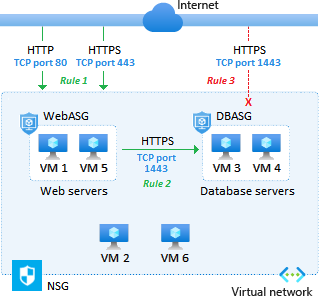Implement application security groups
You can implement application security groups in your Azure virtual network to logically group your virtual machines by workload. You can then define your network security group rules based on your application security groups.
Things to know about using application security groups
Application security groups work in the same way as network security groups, but they provide an application-centric way of looking at your infrastructure. You join your virtual machines to an application security group. Then you use the application security group as a source or destination in the network security group rules.
Let's examine how to implement application security groups by creating a configuration for an online retailer. In our example scenario, we need to control network traffic to virtual machines in application security groups.

Scenario requirements
Here are the scenario requirements for our example configuration:
- We have six virtual machines in our configuration with two web servers and two database servers.
- Customers access the online catalog hosted on our web servers.
- The web servers must be accessible from the internet over HTTP port 80 and HTTPS port 443.
- Inventory information is stored on our database servers.
- The database servers must be accessible over HTTPS port 1433.
- Only our web servers should have access to our database servers.
Solution
For our scenario, we need to build the following configuration:
Create application security groups for the virtual machines.
Create an application security group named
WebASGto group our web server machines.Create an application security group named
DBASGto group our database server machines.
Assign the network interfaces for the virtual machines.
- For each virtual machine server, assign its NIC to the appropriate application security group.
Create the network security group and security rules.
Rule 1: Set Priority to 100. Allow access from the internet to machines in the
WebASGgroup from HTTP port 80 and HTTPS port 443.Rule 1 has the lowest priority value, so it has precedence over the other rules in the group. Customer access to our online catalog is paramount in our design.
Rule 2: Set Priority to 110. Allow access from machines in the
WebASGgroup to machines in theDBASGgroup over HTTPS port 1433.Rule 3: Set Priority to 120. Deny (X) access from anywhere to machines in the
DBASGgroup over HTTPS port 1433.The combination of Rule 2 and Rule 3 ensures that only our web servers can access our database servers. This security configuration protects our inventory databases from outside attack.
Things to consider when using application security groups
There are several advantages to implementing application security groups in your virtual networks.
Consider IP address maintenance. When you control network traffic by using application security groups, you don't need to configure inbound and outbound traffic for specific IP addresses. If you have many virtual machines in your configuration, it can be difficult to specify all of the affected IP addresses. As you maintain your configuration, the number of your servers can change. These changes can require you to modify how you support different IP addresses in your security rules.
Consider no subnets. By organizing your virtual machines into application security groups, you don't need to also distribute your servers across specific subnets. You can arrange your servers by application and purpose to achieve logical groupings.
Consider simplified rules. Application security groups help to eliminate the need for multiple rule sets. You don't need to create a separate rule for each virtual machine. You can dynamically apply new rules to designated application security groups. New security rules are automatically applied to all the virtual machines in the specified application security group.
Consider workload support. A configuration that implements application security groups is easy to maintain and understand because the organization is based on workload usage. Application security groups provide logical arrangements for your applications, services, data storage, and workloads.